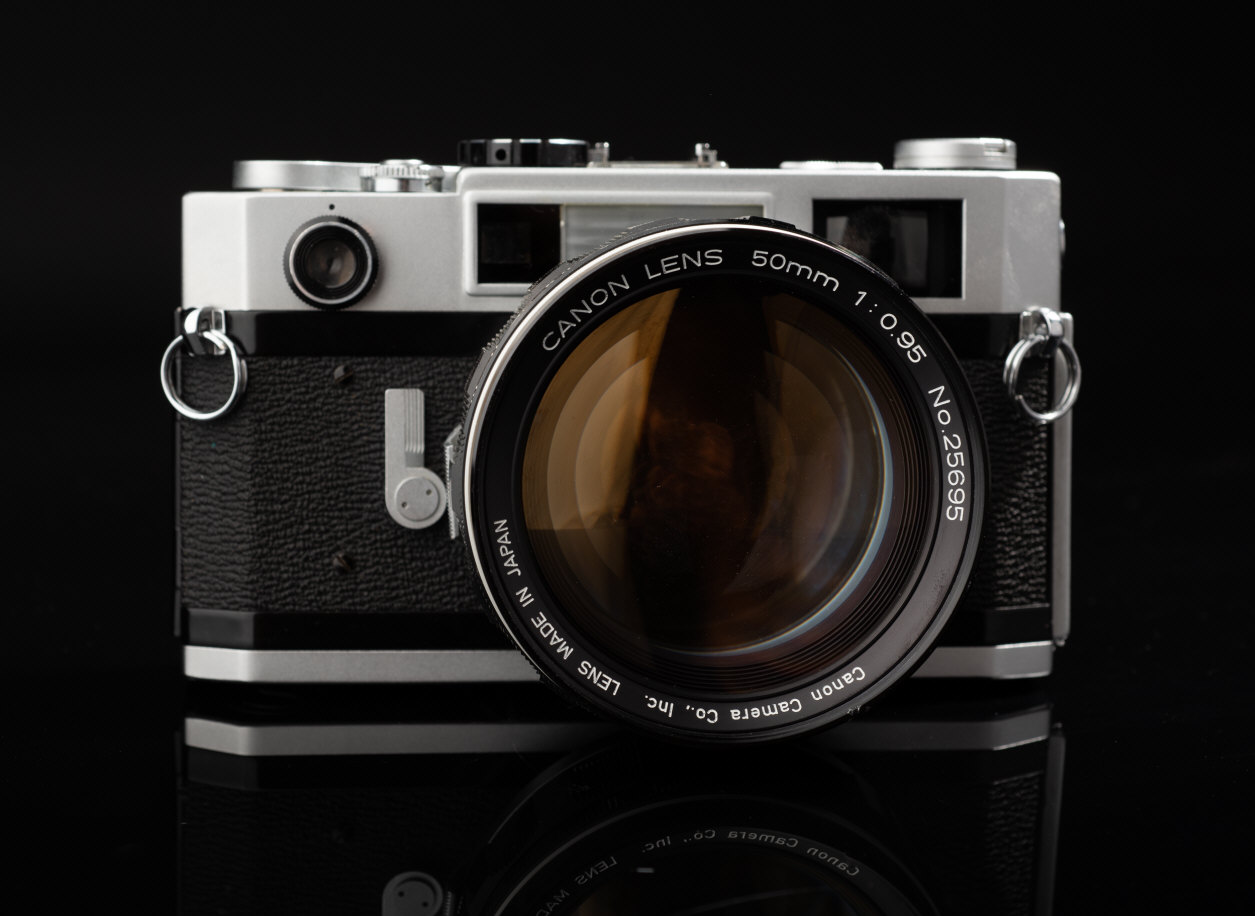
Home Camera Articles FOR SALE Orders I Buy / Wants Repairs Books Adapters
Canon 7/7s/7sZ :
Advanced Classic Leica Screw Mount Camera

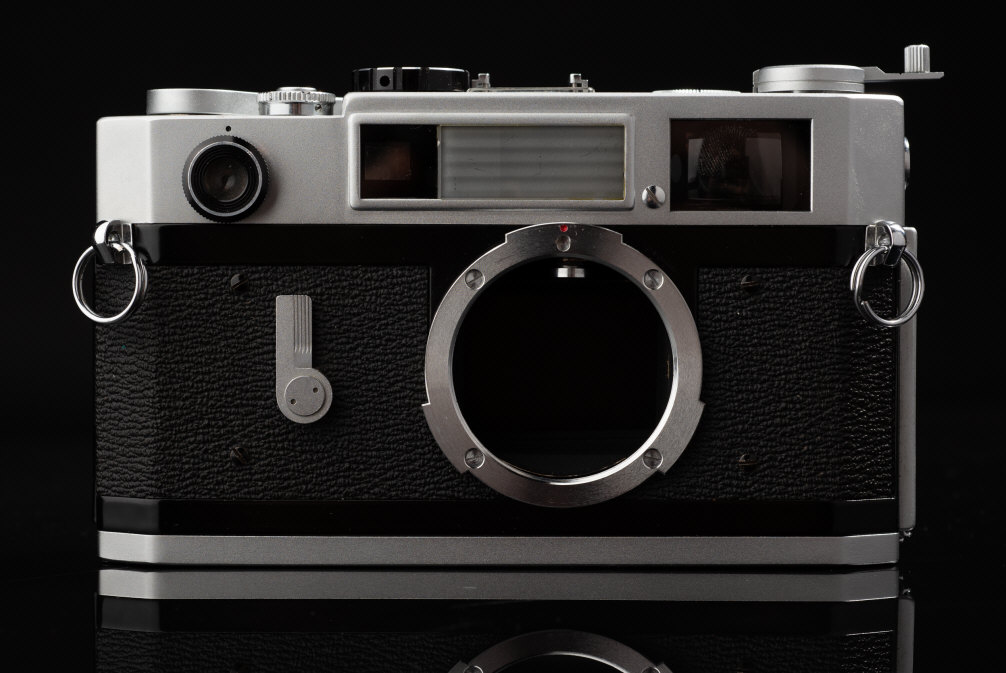
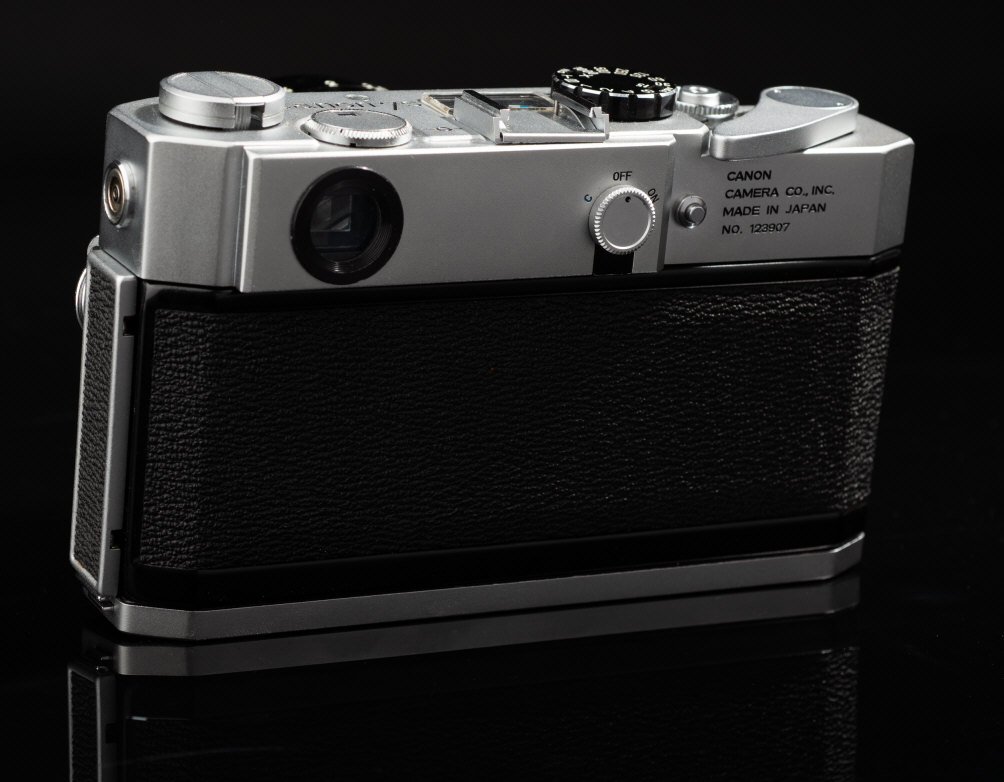

Of all the hundreds of thousands of Leica screw mount cameras (Leica or Leica copies), the Canon 7/7s/7sZ are the most advanced of all. In many ways, they amount to the Leica M4 of Screw mount cameras. Before you get confused, let me explain this trio amounts to small variations of the same camera. Here the 7sZ is shown with the 50/.95, the fastest production 35mm camera lens made to date. Strangely enough, at least one Russian Fed 2 was converted to take the Canon 50/.95!
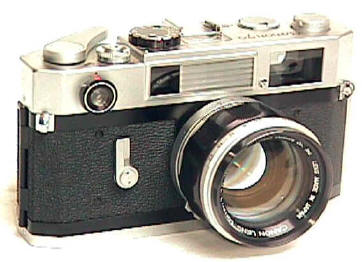
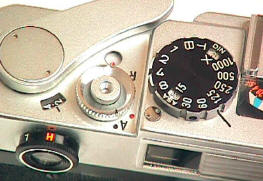
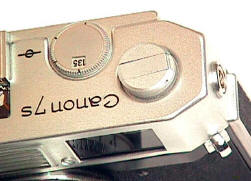
The 7s and 7sZ are almost the same camera. The Z is the rarer and improved version of the 7s, most easily noticeable by its larger rewind knob (compare pics of the 7sZ top, and the 7s to the left). Production is only about 4,000. Production on the regular 7s is only 16,000, while about 4,000 7sZ's were produced. In other words, the 7s is about 30% rarer than a Nikon SP, while the 7sZ is five times rarer!! Not only are both great user cameras, they are also great collectibles as the last of a long line of Canon Rangefinders. Features include:
Five projected parallax corrected framelines in a large rangefinder / viewfinder for 35/50/85/100/135 lenses. Select the frameline by rotating the dial next to the rewind crank. The frame is indicated on top of the camera, as well as in the finder. Notice the conveniently placed sync terminal (unlike the M Leicas where it will often get in you eye), using a convenient standard PC sync, unlike the M3/2/1.
The 7/7s Frameline System is simpler, less confusing, more pleasing than the M6 -- at least to me. The reason is that the M6 has a three position finder, each of which combines two framelines which are not labeled (28/90, 35/135, 50/75) . In contrast, the Canon 7/7s have a four position finder which ARE labeled in the finder and only double up two focal lengths (35, 50, 85/100, 100).
The 7/7s .8 viewfinder makes its very easy to focus WITH BOTH EYES OPEN. This is actually a very big deal since it greatly increases convenience and peripheral vision. Until you try it, you won't be able to appreciate it. Try it!
The 7 and 7s/Z are unique amongst pro 35's by labeling their framelines WITHIN the finder. Select the 35 finder, and you will see "35" in the finder as well as the frameline!
Alas, the ugly part of the 7s design is the ungainly not so beautifully designed advance lever. What were they thinking?
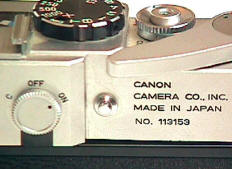
Shown here is the large convenient lever film advance, the larger than average shutter speed dial, the High sensitivity (indoors) / Low sensitivity (outdoors) switch on the CDS cell, the A / R rotating collar to select film advance or rewind, the shutter lock is the red dot next to the "A," the automatic frame counter, the film transport indicator behind the shutter release.
A built in CDS meter with high/low ranges (the only production interchangeable lens professional rangefinder with a CDS meter besides the Leicas). At ASA 100 EV range is EV 2-11, with a modest ASA range of 6-400. The hi/lo switch is on the CDS cell collar, thankfully marked H and L. The On/OFF/Check switch is the button on the back side of the top plate. On check, the battery is good if the needle swings to the far right in the blue section. If the needle is to the left of the far blue section, in the white, replace the battery. Depress the chrome button to the right of the on/off switch to change the ASA. Unfortunately the 7s is designed for the mercury 625 battery. Long-term, you might want to have the meter adjusted for the newer alkaline replacements.
Easy loading with a hinged back. This might not sound like much, but try loading a knob wind Leica, and you will quickly appreciate it.
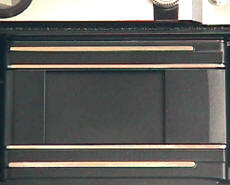
Here you see the rugged and quiet stainless steel shutter curtain. Most 7 and 7s curtains are found wrinkled, thanks to previous owners with large thumbs. Fortunately, the wrinkles don't seem to affect durability. Nevertheless, they are still more durable than any cloth shutter curtain found in Leica Rangefinders. IF they are nosier, the difference is VERY slight.
An often overlooked 7/7s characteristic is their size, which is slightly LARGER (taller, longer, and wider) than a Leica M body. Pictured is a Leica IIIf (front), 7s (middle) and Leica M6 (rear). If you have larger hands, or simply like the feel of a larger camera, this can be a plus.
Only the Canon 7 and 7s(z) have the outer bayonet mount for the super fast Canon 50/.95 and the Canon Mirror Housing 2. Try mounting these on an earlier Canon and you are just SOL.
X Sync at 1/60th
Double Exposures: Turn the film rewind collar to R, then turn the rewind lever enough to rotate the film transport indicator one and a half turns. Strangely enough, turn it two and a half turns, and you will double exposure the frame BEFORE your last one. AFTER rewinding, turn the rewind collar to A for advance, cock the shutter, and enjoy the wild and crazy adventures of multiple exposures before PhotoShop.
Fit and Finish: While the Canon 7/7s/7sZ are wonderful machines and the best classic Canon Rangefinder shooters in terms of great features, when placed side by side to the earlier Canon RF bodies, it's obvious they represent a downgrading of fit and finish. Even as late as the economical P, Canon RF bodies have thick chrome top and bottom plates. The 7 and later have a thinner chrome with thinner plates. I am not saying these are poorly finished cameras, just that the earlier Canon's are heavier built. Put them side by side and see for yourself.
Its worth noting that the term "7sZ" was not created by Canon. It was originally noted by Peter Dechert in his Shutterbug series of Canon articles in the late 70's. Then he called it the "7s Type 2." When his book "Canon Rangefinders" came out, he started calling it the "7sZ" and others followed his lead. Personally I find the "Type 2" designation a lot more logical. The difference between the different versions is a noticeably larger rewind crank(19.5mm wide) on the later type, along with a different position RF adjustment screw.
USER TIP! Have you notice that peculiar little unmarked chrome button on the back side of the top plate? It's the ASA interlock! Press that button and then you will be able to change the ASA setting of your built in meter.
Either version of the 7s is very hard to find, especially in near mint condition. If you are lucky enough to own one, you will not be sorry.
The 7s has a great overall integrated design. It's a great camera use and is one of the best Rangefinder designs ever.
Canon 7

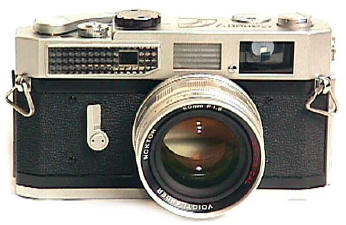
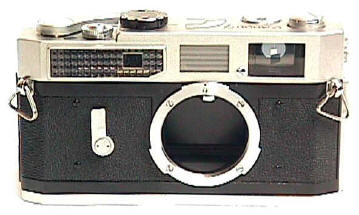

The 1961 predecessor to the 7s is virtually the same camera, except it has a selenium meter instead of a CDS meter. Not too surprisingly, it is the Canon 7. A huge marketing success with over 100,000 produced, the Canon 7 represents a real bargain in today's used rangefinder market. The 7 is a far better user than ANY of the other Canon RFs other than the 7s, and a far better user than ANY of the Leica Screw mount bodies. Its only other disadvantage is not being able to brag to your friends at the country club about how much it cost. Shown mounted is the modern 50/1.5 Voigtlander Ultron Aspherical. The rarest 7 is the ultra rare black finish. It's interesting to me that the 7 often sells for about half the 7s or 7sZ, even though the 7 is MUCH more common and has less desirable features. The way I look at it, either the 7 is selling for more than it should, or the 7s/7sZ is greatly under priced.
Strangely, the 7 has no accessory shoe on the top plate. If you want to add an accessory finder or flash, you have to mount the strange and difficult to find "accessory flash coupler" onto the bayonet mount surrounding the flash sync. It's kind of a strange thing, and a startling oversight that the accessory shoe was not made part of the initial design. Originally selling for about $20, I've seen the accessory flash couplers sell for $120 to frustrated 7 owners who were tired of looking for them. They would have been better off with a 7s.
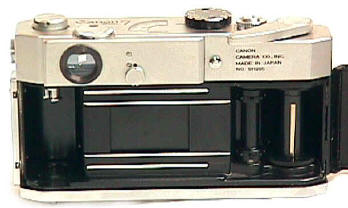
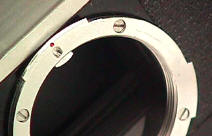
The Canon 7/7s/7sZ series all share very easy loading and a bayonet outer mount for the 50/.095.
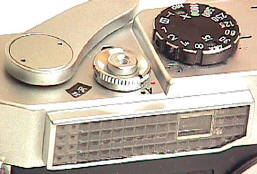
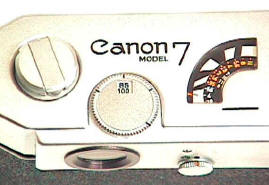
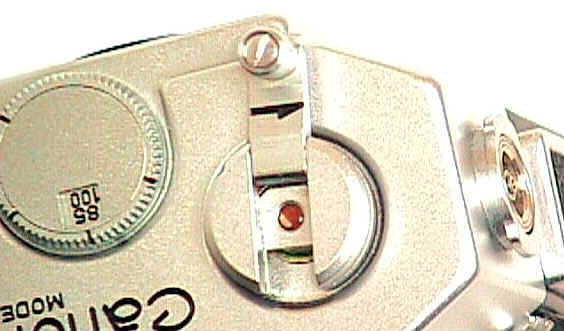
That funny looking horizontal window in front of the shutter release is the window for the selenium meter. What's that? An older exposure meter which did NOT need batteries and was more sensitive to the entire light spectrum than CDS, but not nearly as sensitive in low light. Notice the large well marked shutter speed dial. At ASA 100, the EV sensitivity range is 6 to 19. The ASA range is a modest 6 to 400.
The pic at the right shows the frameline selector dial, at the "85/100" frame in the pic. Between the frame selector dial and the shutter speed dial is the dual scaled meter readings, one for low light and one for high light. If taking photos near the floor you use the low light reading, if near the ceiling you use the high light reading. (That was a photo joke, I hope you didn't believe it) The meter hi/low switch is that small round dial to the right of the eyepiece. Black dot up is the high range, orange dot up is the low range. Not shown but further right is the ASA lock button. Push it down while lifting and turning the shutter speed dial to change the meter's ASA settings.
For all its features, the 7 is a bit of an ugly duckling in the Canon rangefinder lineup. With the large selenium meter, no accessory show, and the not to elegant advance lever, aesthetically its just a bit odd.
The Canon 7/7s/7sZ has some nice features that the Leica M's unfortunately do not. They include: a shutter lock, a film transport window, an overly large shutter speed dial, and a the well placed PC sync post at the end of the camera body. It's better than the Leica M because it's more out of the way and less likely to end up in your eye. While the Canon 7's rewind lever is smaller than 7s/7sZ, it is still large enough to easily do the job. No, this isn't trash Leica M week, these Canons just have some VERY nice features.
Revised: May 21, 2021 . Copyright � 1998-2020 Stephen Gandy. All rights reserved. This means you may NOT copy and re-use the text or the pictures in ANY other internet or printed publication of ANY kind. Information in this document is subject to change without notice. Other products and companies referred to herein are trademarks or registered trademarks of their respective companies or mark holders.